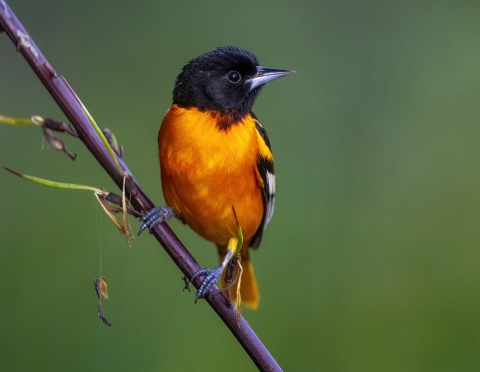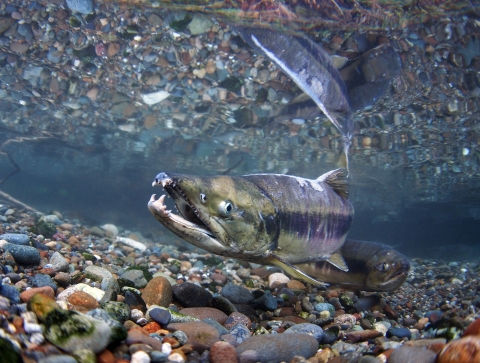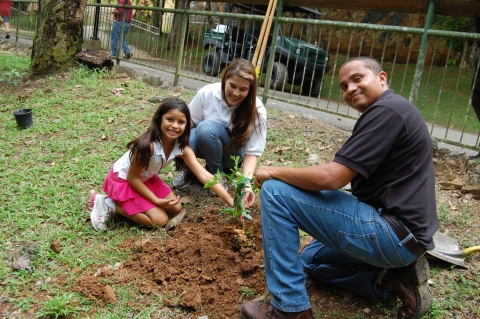It starts with a journey — Baltimore orioles soar through sleeping cityscapes, monarch butterflies flit over dry dusty deserts and country borders, and salmon surge up wildly flowing rivers.
These celebrated animals carry a wealth of information about seasonal patterns and movement across the landscape. Like any traveler, migratory species stay on the lookout for safe rest stops to refuel or recuperate. What happens when these waystations change their hours of operation, become uninhabitable, or disappear altogether? As climate change climate change
Climate change includes both global warming driven by human-induced emissions of greenhouse gases and the resulting large-scale shifts in weather patterns. Though there have been previous periods of climatic change, since the mid-20th century humans have had an unprecedented impact on Earth's climate system and caused change on a global scale.
Learn more about climate change creates an ever-shifting landscape, we and many partners are finding out.
Climate Change and Nature’s Rhythms
According to the National Oceanic and Atmospheric Administration, Earth’s average surface temperature has risen 1.8 degrees Fahrenheit since 1880. While this might not seem like a big change, it has dramatically impacted migratory fish and wildlife.
If you watch birds or track seasonal changes, you have likely noticed recent shifts in nature’s rhythms. Scientists are witnessing these changes, too, through phenology, the study of biological cycles. The deep Native American generational knowledge of seasonal patterns and the movement of wildlife is also informing these changes.
Through this rich phenological record, many are witnessing how climate change, with its warming temperatures, drought, and extreme weather, are altering the availability of food and shelter for migratory species like the Baltimore oriole, monarch butterfly, and Pacific salmon. The result is a climate-induced mismatch between the schedules of fish and wildlife, and the timing of the biological cycles and seasons upon which they rely.
A Baltimore Oriole’s Journey – From U.S. Cities to Tropical Forests
The Baltimore oriole, a raucous, flaming-orange bird arrives in neighborhoods throughout the eastern United States and Canada just as their namesake baseball team gears up for another season. These harbingers of spring rely upon protein-rich insect meals throughout their breeding season, then switch to nectar and fruits while they overwinter in Central and South America. Like all migratory birds, their semi-annual journey must be specifically timed to coincide with the availability of both food and safe rest areas. The travelers also face a multitude of threats such as habitat loss, outdoor cats, window collisions, pollution, pesticides, and disease. Climate change adds further challenge to this bird’s ability to survive.
A review of 48 years of data from ongoing projects, such as the Christmas Bird Count, shows these obstacles are taking their toll. The Baltimore oriole population has dropped 44%, a staggering loss of two out of every five of these birds.
For sure, these threats affect more than the oriole. Since 1970, nearly 3 billion birds overall have disappeared in the United States and Canada.
Grouping bird migration routes into four flyways has allowed us to work internationally through initiatives like the Joint Ventures Program to create corridors of high-quality habitat. Each flyway covers a vast geography. For instance, the Atlantic Flyway stretches from the Hudson Bay to Tierra del Fuego.
Within these flyways, we’re restoring natural areas through innovative biological carbon sequestration partnerships. First, partners purchase degraded land to restore. Once restored, these lands remove, or sequester, the greenhouse gas carbon dioxide from the atmosphere. Because reduction of this gas helps combat climate change, the landowner qualifies for carbon credits – a kind of tradable permit that offsets the emission of a certain amount of carbon dioxide. While retaining the credits, partners then transfer the restored land into our care. This work actively addresses climate change while filling in habitat gaps along migratory flyways. To date, partners have restored more than 70,000 acres in the Lower Mississippi River Valley alone.
A Monarch’s Journey – A Legendary Transcontinental Migration
For many, the monarch butterfly evokes memories of grade school days spent huddled with peers around monarch chrysalises, discovering the wonder of metamorphosis. An ambassador for the world of pollinators, monarchs have inspired countless children and adults alike to witness pudgy striped caterpillars transform into striking orange and black winged butterflies.
Once monarchs take flight, their journey is phenomenal — a voyage of thousands of miles from Mexico to Canada and back, undertaken by an insect with a wingspan of only four inches. These stunning butterflies are also vital pollinators for countless varieties of colorful native wildflowers. Yet this invaluable butterfly, once a common part of our landscape and a symbol of summer, is now at risk.
It takes four generations for monarchs to complete their annual migration, and at each stage they are confronted with unique threats. Their migration timing, reproduction requirements, and overwintering habitat all rely heavily on temperature clues, making monarchs vulnerable to a changing climate. Caterpillars depend on native milkweed as their sole food source and adult butterflies need nectar flowers for refueling. As intensified weather events such as drought, excessive rain, and temperature variability impact these critical food sources, many monarchs are unable to complete their voyage.
Climate change, habitat loss, and pesticide and herbicide use are all contributing factors that are altering natural areas and forcing monarch migration patterns to change at a pace they cannot keep up with. Since the 1990s, we have witnessed a more than 80% decline of monarch butterfly populations in North America. In 2020, we announced monarchs warranted protection under the Endangered Species Act and they are now a candidate species until a listing decision is finalized.
Collaborative conservation efforts in the United States, Mexico, and Canada are crucial to ensuring this important species survives. We’re working with partners, communities, and individual citizens to improve, restore, and create habitats to support monarchs within natural areas and along roadsides and backyards across North America. For example, we’re creating and maintaining butterfly trails and gardens at national wildlife refuges, national fish hatcheries, and community areas across the nation.
A Pacific Salmon’s Journey – From Snowcaps to Sea Caps
Imagine wading through salmon-filled pristine, coldwater streams, or spending summer days floating down wild whitewater rivers fishing and later savoring delicious salmon dishes. These experiences are made possible by a remarkable species that evolved over thousands of years, migrating from freshwater rivers and streams to salt water in the Pacific Ocean, and finally returning to their original natal stream. Their ancestral journey ends when they reproduce, die, and leave behind their vital nutrient-rich bodies to sustain many plants and animals. Because salmon are ecologically important throughout their lifecycle, they are considered a keystone species, a fish upon which the entire ecosystem depends. They are essential culturally and spiritually to many Native peoples and represent the symbol and lifeblood for numerous Tribes who call the Pacific Northwest home. They also have played a critical part in the economy in the Pacific Northwest for generations through recreational and commercial fishing.
Throughout their life, these resilient fish face countless obstacles including predators, habitat loss, pollution, dams, and passage blockages. Only a handful will successfully migrate. The rest will die before they are able to spawn.
These coldwater fish are a federally protected species that faces further challenges from climate change, which is causing an increase in stream and ocean temperatures. This warming alters the timing and magnitude of stream flows, raises sea levels, shorelines, and ocean current patterns – all critical components to a salmon’s successful migration.
In the face of climate change, the Service and many partners, including Tribes, are working collaboratively to sustain salmon populations. Through engaged, multi-stakeholder partnerships, we’re supporting habitat restoration projects, infrastructure and fish passage fish passage
Fish passage is the ability of fish or other aquatic species to move freely throughout their life to find food, reproduce, and complete their natural migration cycles. Millions of barriers to fish passage across the country are fragmenting habitat and leading to species declines. The U.S. Fish and Wildlife Service's National Fish Passage Program is working to reconnect watersheds to benefit both wildlife and people.
Learn more about fish passage improvements, supplementation of wild populations through national fish hatcheries, and community education and engagement.
Ensuring the Splendor of Migration
It is natural to feel concern and even despair about the challenges climate change puts upon wildlife, including migratory species. Fortunately, we can turn this ship around.
Consider the 1970s, when the bald eagle was listed as an endangered species. We at the Service sprang into action, working with multiple partners to tackle the problem. Thanks to these efforts, the beloved bald eagle was removed from the endangered species list in 2007. Not only does this example provide hope, it also reminds us that our most important asset in tackling climate change is each other.
We at the Service are working within communities to protect and restore habitats and green spaces to foster safe havens for migrating species. Join us in these efforts! Create a backyard wildlife garden, add pollinator or native plant gardens to your local parks and schoolyards, or join a local stream restoration project. Observe and report seasonal patterns in your neighborhoods through formal community science groups and initiatives like the National Phenology Network or the Great Backyard Bird Count. As always, keep learning and teaching others about migratory species, climate change and the many ways we can collectively help. For the salmon that navigates strong currents, the monarch that hatches in a hidden patch of milkweed, and the Baltimore oriole that traverses two hemispheres, we can work together to preserve these wonders of nature for present and future generations.
- This article is from the spring 2022 issue of Fish & Wildlife News, our quarterly magazine.
- More Fish and Wildlife News.







